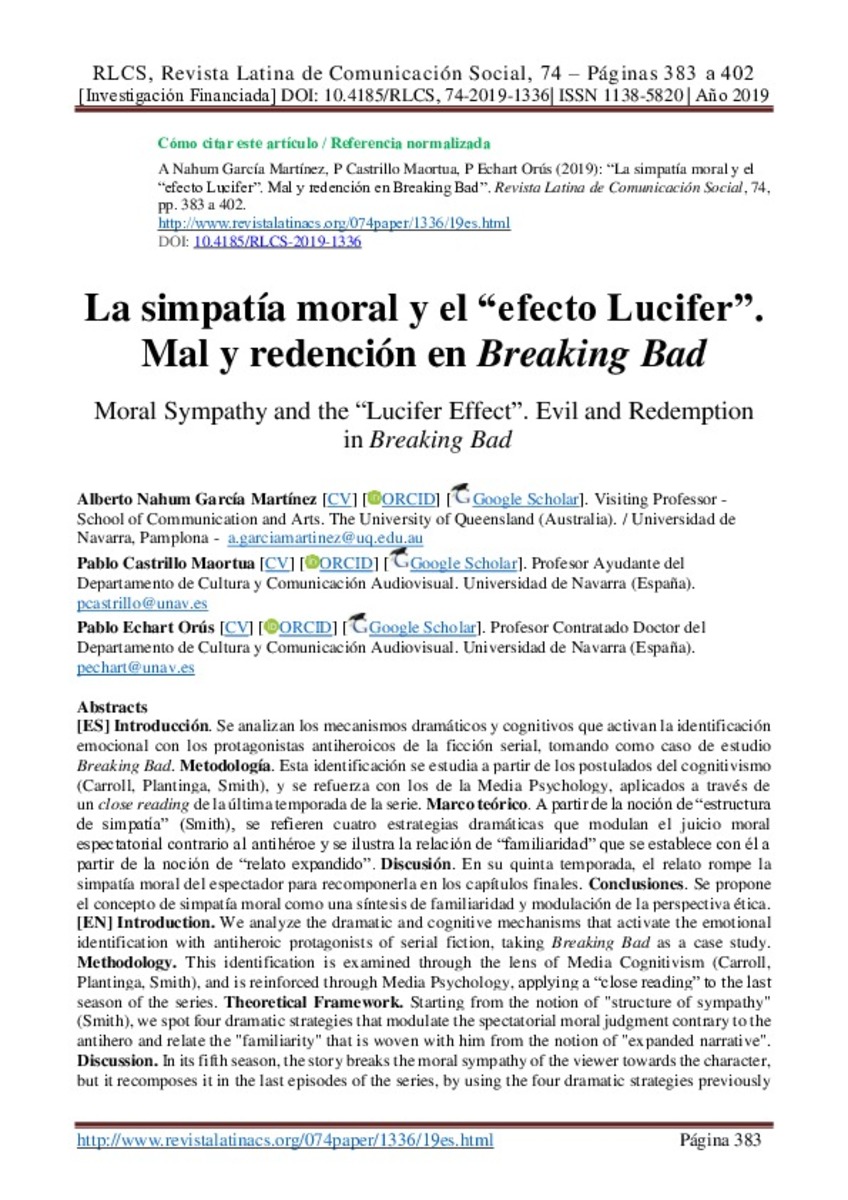Full metadata record
| DC Field | Value | Language |
|---|---|---|
| dc.creator | García-Martínez, A.N. (Alberto Nahum) | - |
| dc.creator | Castrillo, P. (Pablo) | - |
| dc.creator | Echart, P. (Pablo) | - |
| dc.date.accessioned | 2019-02-04T13:40:57Z | - |
| dc.date.available | 2019-02-04T13:40:57Z | - |
| dc.date.issued | 2019-02 | - |
| dc.identifier.citation | Revista Latina de Comunicación Social | es_ES |
| dc.identifier.issn | 1138-5820 | - |
| dc.identifier.uri | https://hdl.handle.net/10171/56396 | - |
| dc.description.abstract | Introduction.This article analyzes the dramatic and cognitive mechanisms that activate viewers’ emotional identification with antihero protagonists of serial fiction, taking Breaking Bad as a case study. Methods. The analysis of the mechanisms that enable identification is based on cognitive media theory (Carroll; Plantinga; Smith), and is reinforced through media psychology, applied through a close reading of the last season of the series. Theoretical framework. The notion of “structure of sympathy” (Smith) is used to identify four dramatic strategies that modulate the spectatorial moral judgment against the antihero, while the concept of the “expanded narrative” is used to explain the familiarity established with the protagonist. Discussion. In its fifth season, the story destroys the viewer’s moral sympathy for the character, but rebuilds it in the last episodes of the series through the aforementioned four dramatic strategies. Conclusion. The concept of moral sympathy is proposed as a synthesis of narrative familiarity and moral modulation of the ethical perspective. | es_ES |
| dc.description.sponsorship | Funded research. This article is the product of the research project CSO2014-51872-R “Strategies for theoretical innovation in the analysis of TV serial narratives”, which is funded by the National R&D Programme focused on the Challenges of Society, of the 2014 National Plan for Scientific and Technical Research and Innovation (Ministry of Economy and Competitiveness of Spain). | es_ES |
| dc.language.iso | eng | es_ES |
| dc.rights | info:eu-repo/semantics/openAccess | es_ES |
| dc.subject | Television Studies | es_ES |
| dc.subject | Moral Emotions | es_ES |
| dc.subject | Breaking Bad | es_ES |
| dc.subject | Antiheroes | es_ES |
| dc.title | Moral sympathy and the “Lucifer effect.” Evil and redemption in Breaking Bad | es_ES |
| dc.title.alternative | La simpatía moral y el “efecto Lucifer”. Mal y redención en Breaking Bad | es_ES |
| dc.type | info:eu-repo/semantics/article | es_ES |
| dc.relation.publisherversion | http://revistalatinacs.org/074paper/1336/19en.html | es_ES |
| dc.description.note | Creative Commons Reconocimiento-No comercial-Sin obras derivadas 3.0 España License. | es_ES |
| dc.editorial.note | Journal Open Access | es_ES |
| dadun.citation.endingPage | 402 | es_ES |
| dadun.citation.publicationName | Revista Latina de Comunicación Social | es_ES |
| dadun.citation.startingPage | 383 | es_ES |
Statistics and impact
Items in Dadun are protected by copyright, with all rights reserved, unless otherwise indicated.







